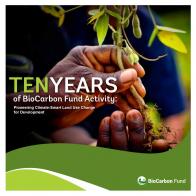The BioCarbon Fund was a World Bank-managed trust fund that is now closed. This website remains available for reference, but no further updates will be made.
Since its establishment in 2004 as the first carbon fund devoted to land use, the BioCarbon Fund supported projects that transformed landscapes and directly benefited rural communities and families. Working on more than 20 projects in 16 countries, the BioCarbon Fund engaged national entities, private firms, and non-governmental organizations in its mission to restore degraded lands, reduce deforestation, plant trees, and help increase yields. As a result of these projects, 15 million tons of CO₂ were sequestered, and the release of 5 million tons of CO₂ was avoided during their first 20 years of operation.
In 2020, the team published a report summarizing the insights and experiences from these emission reductions projects in the land-use sector over the past two decades.
BioCarbon Fund projects helped restore and protect ecosystems and supported land transformation. By planting trees, erosion on degraded land was halted and reversed. By reducing deforestation, fragile ecosystems and biodiversity were protected. By adopting sustainable land management techniques, the productivity of agricultural systems was revived or increased. In all cases, tons of CO₂ were sequestered from the atmosphere or prevented from being released, thereby mitigating climate change. Additionally, the BioCarbon Fund helped link global-level climate change mitigation approaches to on-the-ground social and environmental benefits.
Impact on rural communities
BioCarbon Fund projects delivered important economic, social, and institutional co-benefits that served as key incentives for local communities to participate in project implementation. Social benefits included opportunities for greater land tenure security, new revenue streams for communities with limited sources of income, and improved earnings from higher yields in agricultural, timber, or wood fuel products.
- First issuance of carbon credits for a forestry project under the Clean Development Mechanism (CDM), globally and also in Africa
- First registered Afforestation/Reforestation (A/R) CDM project
- First registered CDM project in several countries (such as Albania, DRC, Ethiopia)
- First A/R methodology approved under the CDM
- First methodology for carbon benefits from sustainable land management approved under the Verified Carbon Standard (VCS)
- Nine carbon accounting methodologies developed and approved
- Tools for carbon modeling and monitoring developed
- Capacity built for various stakeholders, including project entities, governmental agencies, policymakers, and project auditors
- The BioCarbon Fund gained valuable lessons from its pioneering projects and carbon accounting methodologies across different standards, paving the way for the next generation of activities through the BioCarbon Fund Initiative for Sustainable Forest Landscapes (ISFL).
- Zambia: Making Conservation Profitable for Small-Scale Farmers
- Rainforest conservation in Madagascar gets $1.4 million boost
- Madagascar: Ankeniheny-Zahamena Corridor Biodiversity Conservation (REDD+) project (1.13 MB PDF)
- Kenya: Sustainable Agriculture Land Management project (229.72 KB PDF)
- Ethiopia: Humbo Assisted Regeneration project (1.21 MB PDF)
- Insights and Experiences from the BioCarbon Fund Emission Reductions Projects in the Land-Use Sector: An Overview
- From Project to Global Public Good: The story of the Plantar Group – World Bank Partnership (1.19MB PDF)
- BioCarbon Fund Experience: Insights from Afforestation / Reforestation CDM Projects (1 MB PDF)


